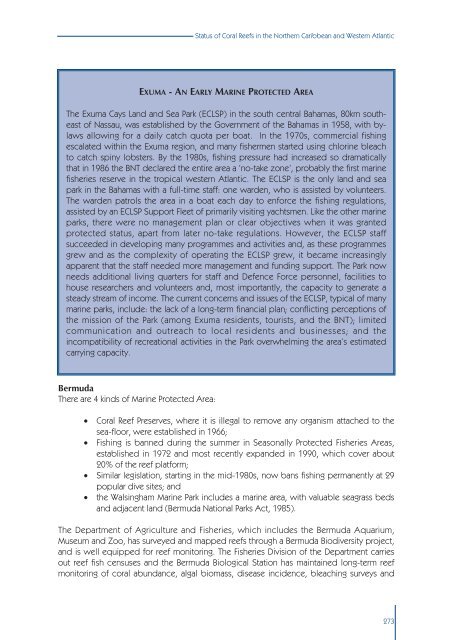Status of Coral Reefs of the World 2000
Status of Coral Reefs of the World 2000.pdf
Status of Coral Reefs of the World 2000.pdf
- No tags were found...
You also want an ePaper? Increase the reach of your titles
YUMPU automatically turns print PDFs into web optimized ePapers that Google loves.
<strong>Status</strong> <strong>of</strong> <strong>Coral</strong> <strong>Reefs</strong> in <strong>the</strong> Nor<strong>the</strong>rn Caribbean and Western Atlantic<br />
EXUMA - AN EARLY MARINE PROTECTED AREA<br />
The Exuma Cays Land and Sea Park (ECLSP) in <strong>the</strong> south central Bahamas, 80km sou<strong>the</strong>ast<br />
<strong>of</strong> Nassau, was established by <strong>the</strong> Government <strong>of</strong> <strong>the</strong> Bahamas in 1958, with bylaws<br />
allowing for a daily catch quota per boat. In <strong>the</strong> 1970s, commercial fishing<br />
escalated within <strong>the</strong> Exuma region, and many fishermen started using chlorine bleach<br />
to catch spiny lobsters. By <strong>the</strong> 1980s, fishing pressure had increased so dramatically<br />
that in 1986 <strong>the</strong> BNT declared <strong>the</strong> entire area a ‘no-take zone’, probably <strong>the</strong> first marine<br />
fisheries reserve in <strong>the</strong> tropical western Atlantic. The ECLSP is <strong>the</strong> only land and sea<br />
park in <strong>the</strong> Bahamas with a full-time staff: one warden, who is assisted by volunteers.<br />
The warden patrols <strong>the</strong> area in a boat each day to enforce <strong>the</strong> fishing regulations,<br />
assisted by an ECLSP Support Fleet <strong>of</strong> primarily visiting yachtsmen. Like <strong>the</strong> o<strong>the</strong>r marine<br />
parks, <strong>the</strong>re were no management plan or clear objectives when it was granted<br />
protected status, apart from later no-take regulations. However, <strong>the</strong> ECLSP staff<br />
succeeded in developing many programmes and activities and, as <strong>the</strong>se programmes<br />
grew and as <strong>the</strong> complexity <strong>of</strong> operating <strong>the</strong> ECLSP grew, it became increasingly<br />
apparent that <strong>the</strong> staff needed more management and funding support. The Park now<br />
needs additional living quarters for staff and Defence Force personnel, facilities to<br />
house researchers and volunteers and, most importantly, <strong>the</strong> capacity to generate a<br />
steady stream <strong>of</strong> income. The current concerns and issues <strong>of</strong> <strong>the</strong> ECLSP, typical <strong>of</strong> many<br />
marine parks, include: <strong>the</strong> lack <strong>of</strong> a long-term financial plan; conflicting perceptions <strong>of</strong><br />
<strong>the</strong> mission <strong>of</strong> <strong>the</strong> Park (among Exuma residents, tourists, and <strong>the</strong> BNT); limited<br />
communication and outreach to local residents and businesses; and <strong>the</strong><br />
incompatibility <strong>of</strong> recreational activities in <strong>the</strong> Park overwhelming <strong>the</strong> area’s estimated<br />
carrying capacity.<br />
Bermuda<br />
There are 4 kinds <strong>of</strong> Marine Protected Area:<br />
• <strong>Coral</strong> Reef Preserves, where it is illegal to remove any organism attached to <strong>the</strong><br />
sea-floor, were established in 1966;<br />
• Fishing is banned during <strong>the</strong> summer in Seasonally Protected Fisheries Areas,<br />
established in 1972 and most recently expanded in 1990, which cover about<br />
20% <strong>of</strong> <strong>the</strong> reef platform;<br />
• Similar legislation, starting in <strong>the</strong> mid-1980s, now bans fishing permanently at 29<br />
popular dive sites; and<br />
• <strong>the</strong> Walsingham Marine Park includes a marine area, with valuable seagrass beds<br />
and adjacent land (Bermuda National Parks Act, 1985).<br />
The Department <strong>of</strong> Agriculture and Fisheries, which includes <strong>the</strong> Bermuda Aquarium,<br />
Museum and Zoo, has surveyed and mapped reefs through a Bermuda Biodiversity project,<br />
and is well equipped for reef monitoring. The Fisheries Division <strong>of</strong> <strong>the</strong> Department carries<br />
out reef fish censuses and <strong>the</strong> Bermuda Biological Station has maintained long-term reef<br />
monitoring <strong>of</strong> coral abundance, algal biomass, disease incidence, bleaching surveys and<br />
273
















